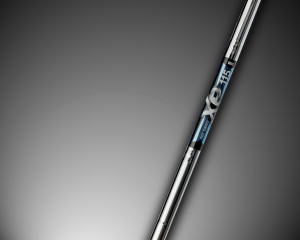 Golf shafts for irons have going through several changes in the last couple of years. As I have mentioned in previous posts, graphite was developed to create a lighter shaft with more shock absorption. The target market was primarily golfers with slower swing speeds and the had joint or hand pain. These shafts were primarily in the 60 to 85 gram range. A few companies (MATRIX, UST) actually made graphite shafts in the 110-120 gram range but they were not wildly popular. Well all of that is changing rapidly. I can now get graphite shafts up to 125 grams, a steel shafts down to 75 grams. But there are inherent issues that you should be careful about when choosing from these new shafts. In general, the slower your swing speed, transition and earlier your release, you can benefit from a lighter shaft in your irons. Of course, the profile (launch and spin) is important as well as the feel (mid section, torque). So let me address the new shaft offerings by weight class:
Golf shafts for irons have going through several changes in the last couple of years. As I have mentioned in previous posts, graphite was developed to create a lighter shaft with more shock absorption. The target market was primarily golfers with slower swing speeds and the had joint or hand pain. These shafts were primarily in the 60 to 85 gram range. A few companies (MATRIX, UST) actually made graphite shafts in the 110-120 gram range but they were not wildly popular. Well all of that is changing rapidly. I can now get graphite shafts up to 125 grams, a steel shafts down to 75 grams. But there are inherent issues that you should be careful about when choosing from these new shafts. In general, the slower your swing speed, transition and earlier your release, you can benefit from a lighter shaft in your irons. Of course, the profile (launch and spin) is important as well as the feel (mid section, torque). So let me address the new shaft offerings by weight class:
40 – 70 gram iron shafts:
These shafts are almost 100% graphite and are offered as stock shafts for a lot of manufacturers like Callaway, Cobra and Ping. Every aftermarket shaft supplier (ACCRA, OBAN, UST Mamiya, Project X, Grafalloy) will have at least one offering in this weight class. Only a few companies (ACCRA, OBAN) offer 40+ gram graphite iron shafts which are used mostly for juniors and beginner lady golfers. There are no aftermarket steel shafts in this weight range because shafts that light are not durable. There is only one composite shaft (metal and graphite) in this weight range, the MCI from Fujikura. Almost all of these shafts are high launch, high spin designed for slow swing speeds.
70 – 80 gram shafts:
While the majority of these shafts are still graphite, there is one steel shaft (ZELOS from Nippon) and a couple of composite shafts from Aerotech (SteelFiber) and Fujikura. Now we see several more options in terms of launch and spin characteristics. A lot of graphite shaft manufacturers will pick a few weight classes (60, 80, 100 gr. or 70, 90 gr.) so you will not necessarily see every aftermarket shaft company in this weight range. OBAN and UST Mamiya are offering a lot of graphite options from as light as 40 grams to over 100 grams. These will typically come as high launch shafts in the lighter weights and mid-low launch in the heavier weights.
80-90 gram shafts:
This is the weight range were you begin to see a lot of crossover in terms of graphite, steel and composite materials. A lot of OEM’s have put shafts like the Reax Steel 87 and True Temper XP 85 in their stock iron offerings with mixed reviews. These light weight steel shafts play very soft to flex so stronger players that try to pick up more swing speed with these light shafts usually end up with lack of consistent ball striking and control problems. Eighty five gram graphite and composite shafts are a very good choice for a wide variety of golfers with moderate swing speeds as there are a lot of options from nearly every shaft company.
90-100 gram shafts:
Now this weight category is where the proverbial gloves are coming off. Aerotech, with their Steel Fiber i95 shafts have proven that even certain PGA Tour players can make the switch from steel to a composite shaft and win! So, the rush has been on for steel manufacturer’s (KBS Tour 90, True Temper XP 95, Nippon 950GH) and graphite manufacturers (MATRIX Program, UST Mamiya Recoil, Graphite Design, Loomis) to make shafts in this weight class. We still see actually more graphite shafts being selected by our customers in this weight class versus steel as we can build a more consistent set of irons for moderate to strong players with a graphite or composite shaft in this weight class.
100-110 gram shafts:
This weight category is probably the smallest today in terms of both our fittings and shaft offerings, but I think it will become much larger. A lot of golfers will switch from the heavier 120+ gram shafts like KBS Tour, Project X and Dynamic Gold to something that has the same ball flight characteristics but is more comfortable to swing. The True Temper XP 105, Nippon 1050 and KBS C-Taper Lite shafts all hit this weight class in steel. The graphite shafts from MATRIX, Aerotech, UST Mamiya, Graphite Design, and Fujikura are all going after this potentially huge marketplace. Again, there are a lot of options in terms of launch and spin characteristics so a good fitting is imperative to get the most out of the shafts you are selecting.
110-120 gram shafts:
Again, this weight category is getting a lot of attention as players are looking for a lighter weight alternative to the traditional Dynamic Gold S300/X100, KBS Tour, Nippon 1050, etc. The newest entrants are the True Temper XP 115 and the KBS Tour-V in steel and a few graphite models. These shafts offer mid to low launch characteristics, with a few options that are “flighted”, meaning the longer iron shafts will launch higher than the shorter iron shafts.
120+ gram shafts:
This weight class is still the mainstay of stronger players. Most of these shafts are sold as taper only but some manufacturers will make parallel tip options. The taper tip shafts will usually have a firmer midsection and tip than their parallel tip cousins, but not always. There are very few pure graphite shaft options in this weight class as the feel tends to be dull. Nippon Modus 120 and Modus 130, True Temper Dynamic Gold S300/X10, Tour Issue and Pro, KBS Tour and C-Taper, Project X, and Shimada Pro are all heavy steel shafts built for iron swing speeds over 90 mph. The Fujikura MCi 120, Aerotech i125 shafts are composite steel and graphite shafts that are the first to hit this category. Launch options are a little limited from mid to low. True Temper did have a High Launch version of the Dynamic Gold shafts a few years ago but opted to do the DG-PRO which is a completely flighted set with each iron shaft tuned for ball flight.
Summary:
With all of the shaft options, it is absolutely critical that you go see a qualified fitter to help you determine the proper shaft weight and launch conditions for you. In general, the smoother your tempo and transition, the lighter the shaft you can play. This will help you generate more club head speed for more distance and higher launch angle. The faster your tempo, club speed and transition, the heavier and stiffer your iron shafts should be to provide you more consistent contact and control. But, you should not have any problem finding the perfect shaft for YOUR swing!
Dan Sueltz
